
(Click on any image below for a larger version)
Monday, January 22: Cape Wild, Elephant Island
It was foggy again the next morning. A light snow was falling. The snow melted as soon as it hit the deck of the ship.
Soon after sunrise, Howard Rosenbaum of the American Museum of Natural History got on the intercom to announce that a Southern Right Whale had been sighted off the port side of the ship. Our stateroom faced out the port side and I could see the whale blowing and surfacing in the distance. At one point it raised a large pectoral fin out of the water. The whale fell behind the ship very quickly.
Through the fog we spotted the first iceberg of the trip. It was a large tabular iceberg. The old, glacial ice was deep blue. The iceberg was grounded, resting on the sea floor as it slowly melted. Soon we could see many other blue icebergs of all shapes and sizes.
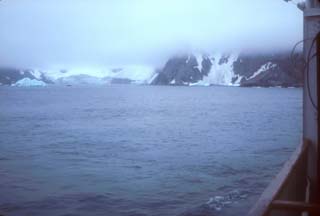 Beyond the icebergs we glimpsed our
first view of land in the Antarctic. The desolate shore of
Elephant Island loomed under the overcast.
Beyond the icebergs we glimpsed our
first view of land in the Antarctic. The desolate shore of
Elephant Island loomed under the overcast.
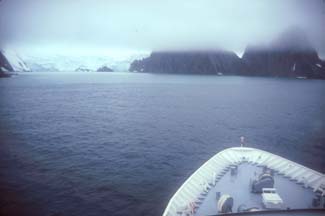 A glacier reached down to the water
in an ice filled bay. The water of the bay could be seen to be
much greener and lighter in color than the ocean water.
A glacier reached down to the water
in an ice filled bay. The water of the bay could be seen to be
much greener and lighter in color than the ocean water.
We had made such good time crossing the Drake Passage, that Captain Notke suggested that we could stop at Cape Wild to see where Ernest Shackelton had left his men 85 years ago. An extra Zodiac cruise was added to the agenda.
Link to a picture of the men that Shackelton left at Cape Wild.
The Antarctic Philately web site has a biography about Ernest Shackelton.
Cape Wild is a Chinstrap Penguin rookery. The rocks along the shore held a large population of the black and white "feathered fish". After a little observation it was easy to see where the penguins were located. The rocks were stained by a thick coating of pink penguin guano.
Link to background information about the Chinstrap Penguin.
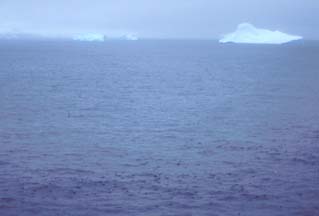 Large flocks of Chinstrap Penguins
were swimming in the water around the ship. They leaped out of
the water like dolphins as they swam.
Large flocks of Chinstrap Penguins
were swimming in the water around the ship. They leaped out of
the water like dolphins as they swam.
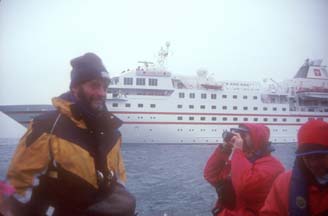 The pilot of our Zodiac was named Heinrich. Two
years ago, Heinrich participated in a recreation of Shackelton's
voyage from Elephant Island to South Georgia Island in the James
Caird, a replica of the small open boat that Shackelton had used.
The pilot of our Zodiac was named Heinrich. Two
years ago, Heinrich participated in a recreation of Shackelton's
voyage from Elephant Island to South Georgia Island in the James
Caird, a replica of the small open boat that Shackelton had used.
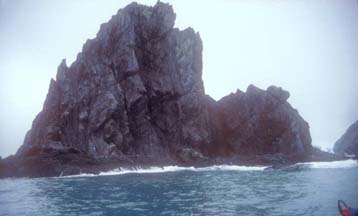 Snowy Petrels and white Sheathbills
wandered among the penguins on the rocks, snacking on the fresh
guano and chick carcasses. Flocks of black and white Cape Petrels
were resting on the water around the harbor, and Southern Giant
Petrels circled overhead.
Snowy Petrels and white Sheathbills
wandered among the penguins on the rocks, snacking on the fresh
guano and chick carcasses. Flocks of black and white Cape Petrels
were resting on the water around the harbor, and Southern Giant
Petrels circled overhead.
 Weddell Seals were resting on the
rocks near the water. Antarctic Fur Seals had climbed farther up
above the surf to stretch out on the rocks. They are more closely
related to California Sea Lions than to the "true
seals". They have external ear flaps and functional hind
limbs, which can propel them across the ground very quickly.
Weddell Seals were resting on the
rocks near the water. Antarctic Fur Seals had climbed farther up
above the surf to stretch out on the rocks. They are more closely
related to California Sea Lions than to the "true
seals". They have external ear flaps and functional hind
limbs, which can propel them across the ground very quickly.
 The inner part of the bay was
filled with slush ice from the calving of icebergs at the foot of
the glacier.
The inner part of the bay was
filled with slush ice from the calving of icebergs at the foot of
the glacier.
 I handed my camera to the passenger sitting
across from me and had him take a picture of Debbie and me in the
Zodiac off Cape Wild.
I handed my camera to the passenger sitting
across from me and had him take a picture of Debbie and me in the
Zodiac off Cape Wild.
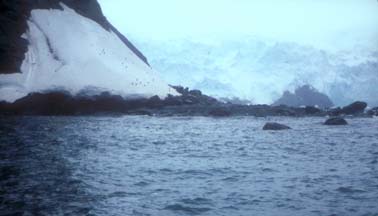 The glacier at the back of the bay
dominated the penguin dotted landscape.
The glacier at the back of the bay
dominated the penguin dotted landscape.
 We could
see a statue mounted on a pedestal on the rocks. It was a bust of
Luis Pardo, the captain of the Yelcho, the Chilean vessel that
succeeded in rescuing Shackelton's men in 1916. Pity the poor
artist who sculpted the bust, only to have it placed in a
location where almost nobody would ever see it. Our Zodiac cruise
of the cape was a very uncommon event and nobody in our group
landed to get a closer look at the statue.
We could
see a statue mounted on a pedestal on the rocks. It was a bust of
Luis Pardo, the captain of the Yelcho, the Chilean vessel that
succeeded in rescuing Shackelton's men in 1916. Pity the poor
artist who sculpted the bust, only to have it placed in a
location where almost nobody would ever see it. Our Zodiac cruise
of the cape was a very uncommon event and nobody in our group
landed to get a closer look at the statue.
 Heinrich steered us through a maze
of blue icebergs. They were resting on the bottom of the harbor.
Each was eroded for several feet above and below the waterline.
Heinrich steered us through a maze
of blue icebergs. They were resting on the bottom of the harbor.
Each was eroded for several feet above and below the waterline.
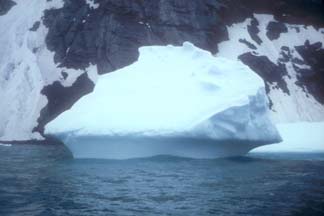 Some if the grounded icebergs had developed
wide overhangs. Fresh fracture faces marked where the icebergs
had recently broken apart. Older bergs had been melted into
smooth, rounded forms.
Some if the grounded icebergs had developed
wide overhangs. Fresh fracture faces marked where the icebergs
had recently broken apart. Older bergs had been melted into
smooth, rounded forms.
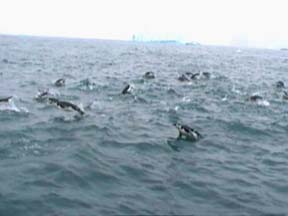 Chinstrap Penguins leaped out of the water around the Zodiac.
Chinstrap Penguins leaped out of the water around the Zodiac.
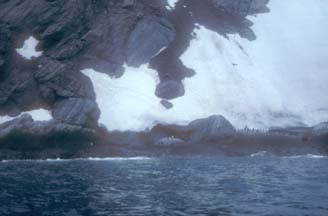 We were taken around a craggy
point, past surging inlets. Penguins were inching their way down
to the water. They watched as the water rose and fell several
feet with each wave. When a particularly large wave lifted the
water nearly to the height of the penguins, several of them took
the opportunity to jump in. Simultaneously, three penguins
rocketed up out of the water and landed on the rocks a few feet
above the water.
We were taken around a craggy
point, past surging inlets. Penguins were inching their way down
to the water. They watched as the water rose and fell several
feet with each wave. When a particularly large wave lifted the
water nearly to the height of the penguins, several of them took
the opportunity to jump in. Simultaneously, three penguins
rocketed up out of the water and landed on the rocks a few feet
above the water.
It was snowing big fluffy flakes by the time that we cruised back to the ship. Each Zodiac took on a new load of passengers as the first load returned to the ship. The water was much rougher than it had been for the Zodiac landings in the Falklands. Each passenger had to carefully time his or her departure from the Zodiac to coincide with the moment that the boat came level with the gangway. Two crewmen grabbed the arms of the passengers to facilitate their exit from the Zodiac.
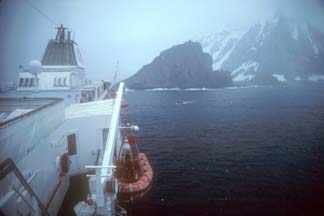 By
the time the last Zodiacs had returned from the cruise it was
snowing heavily. The snow was sticking, lasting long enough to
accumulate on the deck.
By
the time the last Zodiacs had returned from the cruise it was
snowing heavily. The snow was sticking, lasting long enough to
accumulate on the deck.
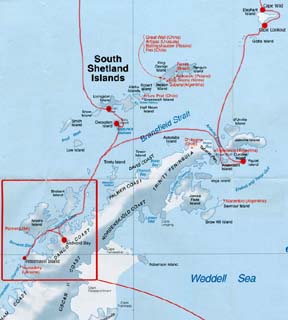 Map of the Antarctic Peninsula.
Map of the Antarctic Peninsula.
 Table of
Contents
Table of
Contents Send a message to Brian.